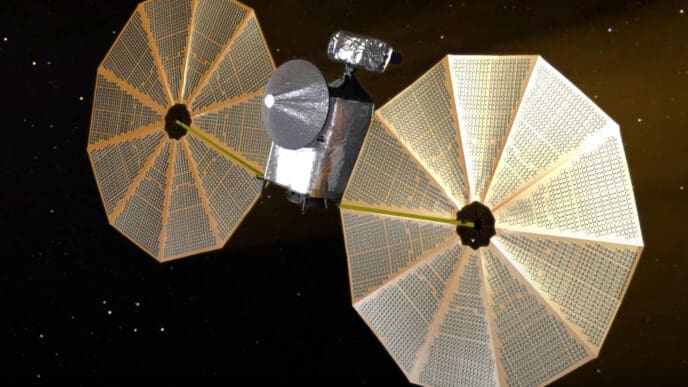The 2024 American Geophysical Union meeting in Washington, D.C., spotlighted an intriguing anomaly on Saturn’s moon Enceladus—an enigmatic dark spot that is puzzling scientists due to its vanishing act over the years.
Enceladus, a moon of Saturn, captivates scientists as a potential haven for life beyond Earth, thanks to its subsurface ocean. This ocean could house life-producing molecules, making any observations of Enceladus’s surface critically important. At the recent American Geophysical Union meeting, a mysterious fading dark mark on Enceladus was a key topic.
Planetary geologist Cynthia B. Phillips from NASA’s Jet Propulsion Laboratory shared how her team identified this anomaly. Through detailed analysis of images captured by NASA’s Voyager and Cassini missions, her crew member Leah Sacks noted something unusual on the moon’s ice shell—a dark spot roughly a kilometer wide that vanished between images taken in 2009 and 2012.
As Phillips detailed, this dark mark was visible in 2009 imagery but appeared to diminish in later photos. Scientists have since tried to understand this oddity. Enceladus is noted for its high albedo, meaning it has a very bright surface, so finding a dark spot at all, let alone one disappearing, is unexpected.
Researchers initially questioned whether the dark spot was a mere photographic illusion due to resolution differences; however, comparisons of images from different years, including higher resolution ones, showed the spot clearly fading rather than a result of image quality.
Could it be a shadow? The team considered this but dismissed the idea after examining how the dark spot behaved under varying light conditions. If it were a shadow, it would become more prominent with higher light incidence, yet it did not. Furthermore, UV and color imaging revealed the spot’s unique reddish-brown hue, differing from other regions.
Phillips speculates that the dark spot may result from a crater impact, with the dark material either being residue from the impactor or exposed bedrock. The intriguing possibility remains that this might reflect something from Enceladus’s subsurface, though Phillips admits this scenario is less likely but highly interesting.
The team proposes that the spot’s disappearance may be due to the moon’s icy plumes depositing layers over time, possibly burying the mark. However, this hypothesis challenges existing knowledge. Since researchers observed changes over a few years, a rapid deposition of ice is considered, but current models suggest it should take around a century for such coverage.
While exploring these theories, researchers also considered other potential contributors, such as particles from Saturn’s E ring, which could accelerate deposition on the moon’s surface. Nevertheless, many questions remain unanswered, including what exactly constitutes the dark spot.
The mystery of the dark spot on Enceladus leaves scientists with more questions than answers. It highlights the dynamic and ever-surprising nature of space research, prompting a reevaluation of existing models and encouraging further exploration of this intriguing moon.
Source: Space












